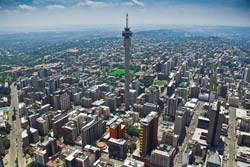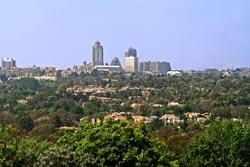Gauteng, South Africa’s economic powerhouse is said to have shown little price deflation during the 2009 period of national house price decline.

The bank believes the Gauteng residential property market is stable compared to other major provinces in the country because its economy is well developed, best diversified and not being exposed to the highly cyclical manufacturing and related sectors of KwaZulu-Natal for example.
According to the FNB Property Barometer Q3 2011 Provincial House Price Indices, Gauteng did not show the same extent of mini recovery as seen nationally in the residential property market.
The bank believes the Gauteng residential property market is stable compared to other major provinces in the country because its economy is well developed, best diversified and not being exposed to the highly cyclical manufacturing and related sectors of KwaZulu-Natal for example.
Gauteng has a very small holiday market relative to the size of its primary residential market and primary residential demand is far less cyclical than holiday residential demand due to the more essential nature.
John Loos, FNB Home Loans property strategist says in Q2 2009, Gauteng price decline bottomed at -2.1 percent year-on-year (y/y) while the national average decline was -5 percent.
In Q2 2011, the FNB Gauteng House Price Index recorded 3.5 percent compared to 10.5 percent in the Western Cape.
He says after a mild renewed acceleration in 2011, the Gauteng House Price Index was ticking along at +3.7 percent y/y growth in Q3 well behind the rejuvenated KwaZulu-Natal and Eastern Cape residential property market.
“Gauteng is South Africa’s main head office region and during tough economic times, corporates centralised most of their work functions to head office cutting back on their operational costs in smaller economic regions,” says Loos.
This may have partly cushioned the employment blow of the recession in Gauteng.
He explains that by comparison, the three major coastal provinces appear to be more cyclical, hitting lower floors in slowdowns and recovering more impressively off a lower base than Gauteng.
Larger holiday property markets play a role while higher exposure to the highly cyclical manufacturing sector in KwaZulu-Natal and the Eastern Cape also contribute to greater cyclicality in recent years.
The Western Cape market led the coastal mini-recovery in 2009/10, but has since settled down to 3 percent y/y price growth in Q3 2011.
He says the Eastern Cape and KwaZulu-Natal lagged the Western Cape in the recovery and both still have higher y/y growth rates - 5 percent in the Eastern Cape and 6.8 percent in KwaZulu-Natal.
“The KZN growth rate was the only one of the three still continuing to accelerate following a very slow recovery out of the 2009 slump.”
The FNB Minor Provinces House Price Index showed mild growth of 4 percent y/y in Q3 2011 higher than the 3.6 percent in the previous quarter.
Loos says these more rural and predominantly inland regions also show some resemblance to the more stable Gauteng market, with the index showing less volatility in recent years than the coastal country regions.
They are less holiday-driven than the coast and heavily exposed to the “non-cyclical” agriculture sector.
The report indicates that the five minor predominantly inland provinces and Gauteng appear more stable than the three major coastal provinces.
He says the inland provinces didn’t suffer the same price decline during the 2008/9 recession but they did not experience as impressive a mini-recovery as the coastal provinces.
“We believe that the average price recoveries made by KwaZulu-Natal, the Eastern and Western Cape were largely driven by the eThekwini, Mandela Bay and Cape Metros with the coastal holiday town regions still remaining the weaker link in those regions’ property markets.”
Gauteng estate agents report an influx of buyers purchasing different types of properties with many eyeing the most sought-after property locations in the province.

Parkmore is well situated and within easy reach of almost every preferred destination in Sandton and Johannesburg.
Chas Everitt International Property Group says the affluent suburb of Parkmore west of the Sandton CBD is seeing an influx of young buyers entering that market.
Area specialist, Brian Robertson says Parkmore offers both convenience and excellent value for money which are essential needs for buyers.
He says what further boosts the Parkmore’s demand is the fact that demographics are changing constantly. Younger couples and families who buy into the area renovate their homes thus lifting both the appearance of the suburb and home values.
“So far this year, there have been 33 confirmed property sales in Parkmore with an average price of R2.17 million which compares very well with a total of 55 sales in 2010 at an average price of R2.02 million,” he says.
They buy three-bedroom family homes that have not been renovated so the new homeowners can do as they like with their purchases.
Parkmore is well situated and within easy reach of almost every preferred destination in Sandton and Johannesburg.
“To live in Parkmore is to live in a convenience node and buyers love the area’s character that seems set to remain essentially suburban despite its proximity to the Sandton CBD,” says Robertson.
Big-ticket buyers of upmarket homes are said to be buying quite actively in the Linksfield and Senderwood node where Johannesburg meets Bedfordview.
Charlene Leibman, Sotheby’s International Realty area specialist says buyers in this area include doctors, specialists and other professionals working at the Netcare Linksfield Hospital.
Big-ticket buyers from much further afield are also said to be buying in these areas and price is not a problem as they want homes with value.
Leibman recently sold two large four bedroom houses in Linksfield and Bedford Park and two luxury cluster homes in Senderwood and Linksfield North for between R7 million and late R8 million.

One of the big-ticket properties recently sold in the Linksfield/ Senderwood area by Sotheby’s International Realty.
“This area is central and has a reputation for high security, with many homes being located in boomed, patrolled areas or gated, guarded complexes.”
She says the most sought-after suburbs in this regard include Essexwold, Linksfield North and Morninghill.
Leibman says high-end buyers are attracted by the value for money available in this area. After the recession hit in 2009, asking prices were too high and properties were staying on the market for a year and more before selling.
Now most sellers have adjusted their expectations in line with current market conditions and sales have sped up considerably as buyers find great value.
She says homes with spectacular views are available on Linksfield Ridge and the Royal Johannesburg golf course being another draw card for buyers.
Many of Gauteng’s wealthy homebuyers and upmarket tenants choose to live in the iconic Silver Lakes Golf Estate on Pretoria’s eastern boundary.
Property prices for luxury homes with at least four bedrooms, three reception areas and three garages cost between R3.5 million and R4.5 million.
Of the total of 1700 stands in the estate, 112 are still vacant and 50 new homes are currently awaiting plan approval or are under construction, says Linda Bodenstein, owner of the RealNet Silver Lakes franchise.

The Silver Lakes golf estate near Pretoria is rapidly approaching full maturity, but continues to attract many upmarket homebuyers and tenants
“About a quarter of all the homes in Silver Lakes are rented – mostly by corporates seeking accommodation for senior employees who are in South Africa on contract and wealthy South Africans.”
Rentals range from around R15 000 a month to R35 000.
Bodenstein says property prices and rentals that are consistently being achieved at Silver Lakes are a good indicator of what is happening at the top end of the real estate market and what it is that homebuyers and tenants in this sector want.
“Security at Silver Lakes is excellent and the estate is at the centre of a developed mixed-use node, surrounded by many other residential, retail and commercial developments.
Probably the greatest attraction, she says, is that the estate is extremely well-run by a very strong Home Owners’ Association (HOA).
As a result, roads are maintained, streetlights work and the communal gardens and parks are immaculate, hence upmarket buyers and tenants value the opportunity to live in this type of environment.
She adds that the HOA recently took ownership of the clubhouse and the Silver Lakes golf course, which was designed by Peter Matkovich and is rated one of the best in Gauteng. – Denise Mhlanga
Readers' Comments Have a comment about this article? Email us now.









